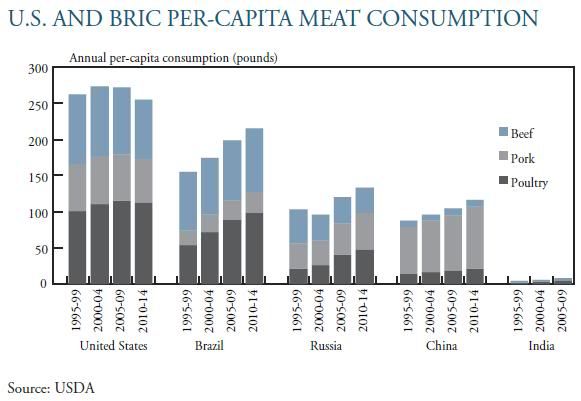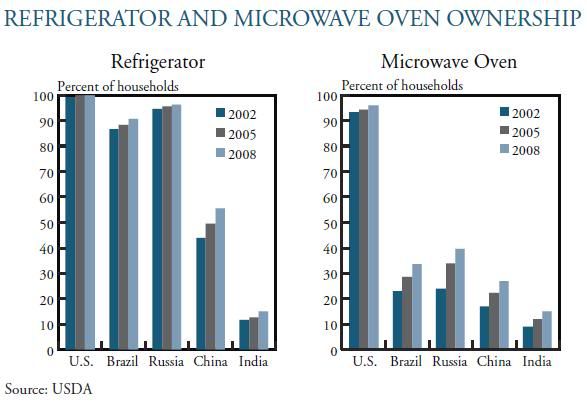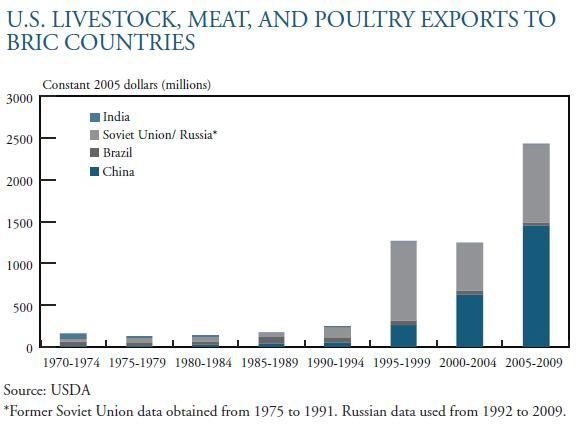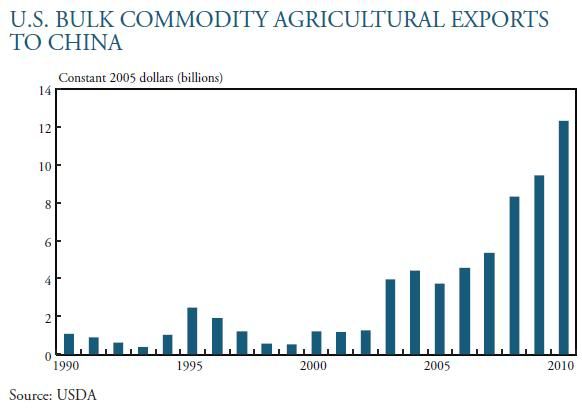Jason Henderson, economist based at the Omaha Branch of the Federal Reserve Bank of Kansas City, has come out with a new publication titled, "Building U.S. Agricultural Exports: One BRIC at a Time." Increasing agricultural exports is an obvious goal of this administration trying desperately to improve our nation's balance sheet.
Normally, a low dollar aids our nation in increasing agriculture commodity exports, but ironically we seem to be killing that benefit these days in our corn ethanol program. Last week, corn exports were down despite extremely low stocks globally and news of poor planting season weather. Demand has been curtailed by corn's high price which has spilled over to high prices of soy, wheat, meat, dairy, oils and eggs.
While Jeremy Grantham and Lester Brown are "sky is falling" predictors of gloom for agriculture, Henderson seems to fear the exact opposite. In fact, he is worried about our ability to increase our Ag exports due to "fierce competition." This is really quite remarkable and echoes what I've suggested as a possibility many times, here on this blog.
Here's Henderson:
We have more and more global competition in agricultural commodity production and for export market share. Grantham doesn't seem to recognize this. We have a looming oil supply problem and our modern "efficiencies" of industrialized agriculture are reliant upon fossil fuels. This, Henderson doesn't seem to acknowledge. It will be a coming race between these two momentums.
There is one more thing to take into account here. As our own nation's agricultural exports are challenged by those of nations elsewhere, then our biofuels policy will be driving up the costs of our own food at the same time we might be pricing ourselves out of competitive global Ag commodity markets.
To follow are graphs and quotes from Henderson's article, "Building U.S. Agricultural Exports: One BRIC at a Time."
K. McDonald
~~~~~

Since 2000, BRIC protein consumption has risen steadily. Per-capita meat consumption in the four counties rose more than 15 percent. Brazil, with its well-developed livestock sector and status as a middle income country, has the highest per-capita meat consumption among BRIC countries, with additional gains expected in coming years. Russia, despite sharp economic contractions during the recent recession, still posted stronger meat consumption gains over the decade, and sustained growth is projected for the future.
China, after posting strong gains during the 1990s, continued to bolster its per-capita meat consumption over the last decade, with its meat consumption expected to rise even further. India has almost doubled its meat consumption during the past decade, but the average Indian still consumes less than 10 pounds of meat per year, reflecting the country’s low-income status.
~~~~~

With stronger incomes, BRIC consumers are also able to afford household amenities that allow them to eat more processed foods. Consumers in middle-income countries are eating more like those in high-income countries by increasing their purchases of packaged and fast foods. Over the past decade, increasing numbers of BRIC households have incorporated refrigerators and microwaves into their lifestyles, with nearly all Russian and Brazilian households owning a refrigerator and between 10 and 30 percent of BRIC households owning a microwave.
In addition to enabling the preservation and preparation of meats, the more widespread use of refrigerators and microwave ovens has increased the demand for processed foods. According to the U.S. Department of Agriculture (USDA), from 2003 to 2008 spending on ready-to-eat meals rose roughly 28 percent in India, almost 20 percent in Brazil and Russia, and 12 percent in China.
~~~~~

In each BRIC country, U.S. agricultural producers have been able to seize market opportunities. In the last half of the 1970s, the value of annual U.S. livestock, meat, and poultry exports to the former Soviet Union rose to more than $72 million and remained near this level until the collapse of the Soviet Union in 1989. Subsequently, U.S. exports to Russia rose sharply, topping $1 billion a year by the mid-1990s. In the 1980s, U.S. livestock, meat, and poultry exports to Brazil tripled to almost $100 million per year by the end of the decade.
Since then, annual U.S. meat exports to Brazil have fallen to roughly $40 million. In the 1990s, China emerged as a major market for U.S. livestock exports. Even with wide fluctuations associated with Avian flu, Mad Cow disease, the Beijing Olympics, and poultry trade restrictions, China now accounts for more than 10 percent of U.S. livestock, meat and poultry exports, up from less than one half of 1 percent in the 1980s. Annual U.S. meat exports to China amounted to more than $1.5 billion between 2005 and 2009.
~~~~~

With the increase in feed consumption, U.S. crop exports to BRIC countries have grown, especially to China. China has emerged as the leading BRIC destination for U.S. bulk commodities and crops. The value of U.S. bulk commodity exports to China has soared over recent years. The annual value of these exports averaged less than $2 billion from 1990 to 2002, rose to about $4 billion in 2005, and reached $12.3 billion in 2010. China accounted for more than 95 percent of all U.S. bulk commodity and crop exports to BRIC countries over the past five years.
United States soybean exports have led bulk commodity trade with China, surging nine-fold during the past decade to almost $10 billion in 2010. The value of U.S. feed grain exports to China rose to almost $900 million in 2010, well above the annual average of $50 million at the beginning of the decade. United States bulk commodity and crop exports to other BRIC countries have risen sharply in recent years, despite being small in quantity. As a major crop producer, Brazil imports few U.S. bulk commodities besides wheat, which tends to be used for food consumption.
India’s bulk commodity purchases are concentrated in dry beans, dry peas, and lentils—crops with high protein content used for food and feed. Russia imports the smallest amount of U.S. bulk commodities and crops, purchasing less than $100 million annually. However, with stronger livestock production, Russia has started to purchase more U.S. soybeans and feed grains.
~~~~~
~~~~~
~~~~~
Henderson concludes:
source: [pdf]
See previous posts:
Normally, a low dollar aids our nation in increasing agriculture commodity exports, but ironically we seem to be killing that benefit these days in our corn ethanol program. Last week, corn exports were down despite extremely low stocks globally and news of poor planting season weather. Demand has been curtailed by corn's high price which has spilled over to high prices of soy, wheat, meat, dairy, oils and eggs.
While Jeremy Grantham and Lester Brown are "sky is falling" predictors of gloom for agriculture, Henderson seems to fear the exact opposite. In fact, he is worried about our ability to increase our Ag exports due to "fierce competition." This is really quite remarkable and echoes what I've suggested as a possibility many times, here on this blog.
Here's Henderson:
If BRIC countries continue to expand their livestock production, U.S. crop producers may benefit the most from rising protein demand, although competition for these markets will be fierce. ... The article concludes that, as BRIC countries increasingly try to satisfy their growing demand for proteins with domestic livestock production, the sharpest gains in U.S. exports may not emerge from protein but from feed crops. Yet, even these bright opportunities may be dulled as BRIC countries bolster their own grain production.As the BRIC nations increase efficiency of their livestock production methods, they will gain a great amount of productivity, meeting much of their own new meat demand. Ditto for grain needs.
We have more and more global competition in agricultural commodity production and for export market share. Grantham doesn't seem to recognize this. We have a looming oil supply problem and our modern "efficiencies" of industrialized agriculture are reliant upon fossil fuels. This, Henderson doesn't seem to acknowledge. It will be a coming race between these two momentums.
There is one more thing to take into account here. As our own nation's agricultural exports are challenged by those of nations elsewhere, then our biofuels policy will be driving up the costs of our own food at the same time we might be pricing ourselves out of competitive global Ag commodity markets.
To follow are graphs and quotes from Henderson's article, "Building U.S. Agricultural Exports: One BRIC at a Time."
K. McDonald

Since 2000, BRIC protein consumption has risen steadily. Per-capita meat consumption in the four counties rose more than 15 percent. Brazil, with its well-developed livestock sector and status as a middle income country, has the highest per-capita meat consumption among BRIC countries, with additional gains expected in coming years. Russia, despite sharp economic contractions during the recent recession, still posted stronger meat consumption gains over the decade, and sustained growth is projected for the future.
China, after posting strong gains during the 1990s, continued to bolster its per-capita meat consumption over the last decade, with its meat consumption expected to rise even further. India has almost doubled its meat consumption during the past decade, but the average Indian still consumes less than 10 pounds of meat per year, reflecting the country’s low-income status.

With stronger incomes, BRIC consumers are also able to afford household amenities that allow them to eat more processed foods. Consumers in middle-income countries are eating more like those in high-income countries by increasing their purchases of packaged and fast foods. Over the past decade, increasing numbers of BRIC households have incorporated refrigerators and microwaves into their lifestyles, with nearly all Russian and Brazilian households owning a refrigerator and between 10 and 30 percent of BRIC households owning a microwave.
In addition to enabling the preservation and preparation of meats, the more widespread use of refrigerators and microwave ovens has increased the demand for processed foods. According to the U.S. Department of Agriculture (USDA), from 2003 to 2008 spending on ready-to-eat meals rose roughly 28 percent in India, almost 20 percent in Brazil and Russia, and 12 percent in China.

In each BRIC country, U.S. agricultural producers have been able to seize market opportunities. In the last half of the 1970s, the value of annual U.S. livestock, meat, and poultry exports to the former Soviet Union rose to more than $72 million and remained near this level until the collapse of the Soviet Union in 1989. Subsequently, U.S. exports to Russia rose sharply, topping $1 billion a year by the mid-1990s. In the 1980s, U.S. livestock, meat, and poultry exports to Brazil tripled to almost $100 million per year by the end of the decade.
Since then, annual U.S. meat exports to Brazil have fallen to roughly $40 million. In the 1990s, China emerged as a major market for U.S. livestock exports. Even with wide fluctuations associated with Avian flu, Mad Cow disease, the Beijing Olympics, and poultry trade restrictions, China now accounts for more than 10 percent of U.S. livestock, meat and poultry exports, up from less than one half of 1 percent in the 1980s. Annual U.S. meat exports to China amounted to more than $1.5 billion between 2005 and 2009.

With the increase in feed consumption, U.S. crop exports to BRIC countries have grown, especially to China. China has emerged as the leading BRIC destination for U.S. bulk commodities and crops. The value of U.S. bulk commodity exports to China has soared over recent years. The annual value of these exports averaged less than $2 billion from 1990 to 2002, rose to about $4 billion in 2005, and reached $12.3 billion in 2010. China accounted for more than 95 percent of all U.S. bulk commodity and crop exports to BRIC countries over the past five years.
United States soybean exports have led bulk commodity trade with China, surging nine-fold during the past decade to almost $10 billion in 2010. The value of U.S. feed grain exports to China rose to almost $900 million in 2010, well above the annual average of $50 million at the beginning of the decade. United States bulk commodity and crop exports to other BRIC countries have risen sharply in recent years, despite being small in quantity. As a major crop producer, Brazil imports few U.S. bulk commodities besides wheat, which tends to be used for food consumption.
India’s bulk commodity purchases are concentrated in dry beans, dry peas, and lentils—crops with high protein content used for food and feed. Russia imports the smallest amount of U.S. bulk commodities and crops, purchasing less than $100 million annually. However, with stronger livestock production, Russia has started to purchase more U.S. soybeans and feed grains.
Increased feed use is expected to lift Chinese and Russian crop imports in the next decade. Due to rising demand for feed, China is projected to import more than 4 million metric tons of corn by 2019, up from 40,000 thousand metric tons today. At the same time, China’s soybean imports are expected to rise more than 40 percent. In Russia, soybean imports are expected to rise more than 30 percent with strong gains in feed use, while corn imports are expected to remain limited. India’s imports of corn and soybean are projected to double with feed use. As a result, rising protein demand could spur additional trade opportunities for U.S. crop farmers if BRIC countries enhance the productivity of their livestock operations.
United States producers, however, will face tough competition in these feed export markets. As a leading competitor in global crop markets, Brazil accounts for roughly a quarter of world soybean trade and 6 percent of world coarse grain trade. Similar to its experience in livestock markets, Brazil has demonstrated how crop production evolves with economic development. While nations initially import grains to feed a larger livestock sector, the incorporation of advanced technology allows them to spur their own grain production. While China and Russia may offer near-term export opportunities for U.S. crop farmers, they could follow Brazil’s lead in adopting technologies to boost yields—and thus satisfy their own feed demand. For example, if China and Russia narrowed the gap by half between their corn yields and U.S. standards, annual corn production in these countries could rise more than 50 percent in the next decade, limiting their imports.
"Some analysts suggest that by 2040, BRIC countries could become four of the five largest world economies, trailing only the United States (O’Neill and Stupnytska)."
Henderson concludes:
With expectations of further economic gains, global food demand is likely to grow briskly. The competition to satisfy the hungry appetites of BRIC nations, however, will be fierce as agricultural producers around the global strive to produce the processed foods and proteins demanded by more affluent consumers. The fiercest competitors might be the BRIC countries themselves, depending on their stage of development. Their investments in animal production systems might limit U.S. meat export opportunities but widen the door for feed crop exports. With arable land for agricultural production available in BRIC countries, competition in their markets could be fierce, especially if Russia, India, and China follow Brazil’s lead to self-sufficiency.
source: [pdf]
See previous posts: